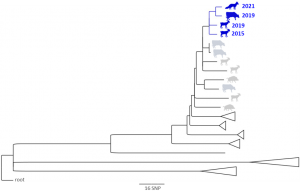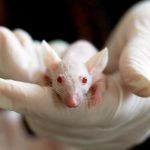A new actor in the tuberculosis puzzle?

Next-generation sequencing tools have made it possible to link a case of generalized tuberculosis (TB) in a fox caused by the bacterium Mycobacterium caprae with outbreaks of TB in domestic animals. This is the first case of TB caused by this bacterium detected in a fox in the Iberian Peninsula.
Although it is well known that among wild carnivores, badgers can suffer from TB and transmit the infection to other animal species, in recent years a series of cases of TB have been reported in foxes in Europe. Now, in Catalonia, thanks to the massive new sequencing tools, we have been able to link a case of generalized TB in a fox caused by the bacterium Mycobacterium caprae with an outbreak of TB in a bovine farm in the same village. In addition, the data also suggest a relationship with two other outbreaks of TB in goats.
The fox was found blind and malnourished. Subsequently, the animal was sent to Centre de Fauna de Vallcalent and, after a clinical evaluation, the animal was euthanized and sent Servei d’Ecopatologia de Fauna Salvatge (SEFaS) from Universidat Autònoma de Barcelona to carry out a necropsy. After the necropsy, lesions from systemic TB infections were observed. The infection was later confirmed by histopathology with Distemper virus co-infection. Subsequently, the samples were transferred to the IRTA-CReSA’s Biocontainment Unit where the microbiological culture was carried out and the Mycobacterium caprae bacterium was isolated.
In collaboration with the US Department of Agriculture’s National Veterinary Services (NVLS-USDA), a whole genome sequencing study of this M. caprae strain isolated from the fox was performed and analysed alongside other M. caprae strains isolated from domestic and wild animals around Catalonia. The results showed a close phylogenetic relationship of the isolated M. caprae from the fox with those obtained from a cattle herd in the same municipality a few months earlier, indicating transmission by direct or indirect contact between cattle and the fox. The analysis also identified proximity, although to a lesser extent, with isolates from two goat farms that could be indirectly related to the outbreak.

Phylogenetic tree of M. caprae strains isolated in Catalonia. The strain isolated from the fox in 2021 was related to the strain isolated from a herd of cattle in 2019 (< 1Km) and two herds of goats (2015 and 2019).
This study, financed by the Department of Climate Action, Food and Rural Agenda, Interreg-POCTEFA (EFA357/19/INNOTUB) and FEDER, has recently been published in the scientific journal BMC Veterinary Research.
These results highlight the usefulness of a good passive surveillance system in wildlife, as well as the need to take TB into account in the differential diagnosis in foxes with poor body condition and the possibility of including this species in active surveillance campaigns of TB in wildlife.
Paper reference:
Bernat Pérez de Val, Claudia Perea, José Estruch, Carlos Solano-Manrique, Carlos Riera, Albert Sanz, Enrique Vidal, Roser Velarde. Generalized TB leads to Mycobacterium caprae in red fox phylogenetically related to livestock breakdowns. BMC Vet Nada 18, 352 (2022). https://doi.org/10.1186/s12917-022-03454-7













